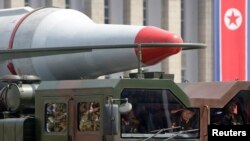A former high-level International Atomic Energy Agency official has expressed skepticism about a new report that North Korea could manufacture 100 nuclear weapons by 2020.
“I would be really surprised if they can pull 100 nuclear weapons in the next six years. I don’t think anyone has done it, not even the United States of America,” said Ollie Heinonen, former deputy director general at the U.N. nuclear agency, in a telephone interview with VOA’s Korean Service.
Last month, the U.S.-Korea Institute at John Hopkins University’s School of Advanced International Studies, a research institution in Washington, offered an estimate of Pyongyang’s nuclear stockpile.
“North Korea’s nuclear stockpile grows more rapidly than in the previous scenarios to 100 weapons by 2020, an increase of 525 percent,” the report said.
“Pyongyang’s nuclear and missile programs appear poised for significant expansion over the next five years, presenting a serious challenge to the United States, Northeast Asia and the international community,” the report warned.
The report came as the standoff over Pyongyang’s nuclear weapons program continues. Washington and Pyongyang have been deadlocked in talks since late 2008.
Heinonen expressed skepticism about the assessment, saying the estimate of Pyongyang’s nuclear stockpile should be taken as the amount of fissile material, not the number of nuclear weapons, as the report projected.
“There is a difference between having nuclear material for a weapon and having a [nuclear] weapon,” the nuclear expert explained.
“A [nuclear] weapon is a very complicated thing and it takes time to manufacture,” he added.
Citing recent satellite imagery, 38 North, a North Korea monitoring website run by the John Hopkins U.S.-Korea Institute, said Tuesday there is no sign of an imminent nuclear test by Pyongyang.
Heinonen said the communist country could develop a nuclear weapon without having to test it. Part of the testing can be omitted by getting assistance from other countries, and some crucial information can be obtained through computer simulations, he said.
Jee Abbey Lee contributed to this report.






